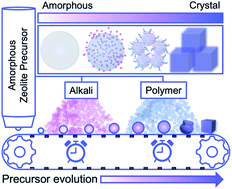Manipulation of amorphous precursors to enhance zeolite nucleation†
Abstract
Crystallization in media comprised of amorphous precursors is becoming a more common phenomenon for numerous synthetic, biological, and natural materials that grow by a combination of classical and nonclassical pathways. Amorphous phases can exhibit a wide range of physicochemical properties that may evolve during the course of nucleation and crystal growth. This creates challenges for establishing causal relationships between amorphous precursor properties and their effect(s) on the selection of mechanistic pathways of crystallization and ultimately the properties of the crystalline product. In this study, we examine ways to manipulate the composition and colloidal stability of amorphous (alumino)silicate precursors that are prevalent in nanoporous zeolite syntheses. Changes in the amorphous precursor properties are evaluated on the basis of their ability to enhance rates of crystal formation. Here, we use fumed silica as the primary silicon source and examine the effects of infusing the source or growth medium with additional alkali metal, which serves as an inorganic structure-directing agent to facilitate the formation of porous crystal structures. We also assess the impact of adding a polymer additive, which reduces the colloidal stability of precursors, wherein we posit that the confined pockets of solution within the interstitial spaces of the precursor aggregates play an important role in regulating the rate of zeolite crystallization. Three commercially relevant zeolites (mordenite, SSZ-13, and ZSM-5) were selected for this study based on their diverse frameworks and methods of preparation. Our findings reveal that alkali infusion significantly reduces the crystallization times for mordenite and SSZ-13, but has little impact on ZSM-5 synthesis. Conversely, we find that polymer addition markedly enhanced the rates of crystallization among all three zeolites, suggesting that this method may be a general approach to reduce zeolite synthesis times. Given the relatively high costs associated with commercial zeolite production, identifying new methods to improve the efficiency of hydrothermal syntheses can have significant practical implications beyond the fundamental benefits of developing new routes to tailor nonclassical crystallization.

- This article is part of the themed collection: Understanding Crystallisation


 Please wait while we load your content...
Please wait while we load your content...